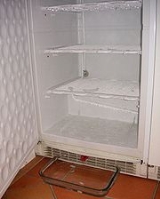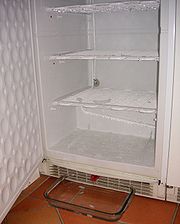
Defrost
Encyclopedia
Defrosting is a procedure, performed periodically on refrigerator
s and freezers to maintain their operating efficiency. Over time, as the door is opened and closed, letting in new air, water vapour from the air condenses on the cooling elements within the cabinet. It also refers to leaving frozen food at a higher temperature prior to cooking.
 The resulting ice
The resulting ice
inhibits heat transfer out of the cabinet increasing running costs. Furthermore as the ice builds up it takes increasing space from within the cabinet - reducing the space available for food storage.
Defrosting the unit is achieved by:-
The process may be sped up by mechanical removal of ice, or the introduction of gentle heat into the cabinet. Placing a pan of hot water in the cabinet and closing it is an effective method. Using a fan to blow in room temperature air will also greatly speed up the melting process as well as help to evaporate the damp surfaces. Note that the fastest manual way is to use a vacuum cleaner: simply insert the hose into the exhaust port (nearly all are designed for this), and use the wand to blow on the coils; this method is much faster than any other.
Any mechanical removal of ice should be done gently so that the equipment is not damaged.
It is generally recommended that defrosting should be done annually.
Many newer units employ automatic defrosting (often called "frost-free" or "no frost") and do not require manual defrosting in normal use. Although, in some cases, users of Frost Free fridge/freezers have noted ice blocking the vent that allows air into the refrigerator compartment. All refrigerators and/or freezers whether or not frost free, should be defrosted at least every 6 months (or more if you live in humid conditions or if the door is opened excessively).
Frost Free units should be defrosted every year, as frost can form on the evaporator covers, which can look unsightly and degrades freezing performance, sometimes to the point of the freezer thawing out due to degradation of defrosting. This can happen when the defrost timer is not set up correctly/malfunctioning or if the heater units or temperature sensors are malfunctioning.
Refrigerator
A refrigerator is a common household appliance that consists of a thermally insulated compartment and a heat pump that transfers heat from the inside of the fridge to its external environment so that the inside of the fridge is cooled to a temperature below the ambient temperature of the room...
s and freezers to maintain their operating efficiency. Over time, as the door is opened and closed, letting in new air, water vapour from the air condenses on the cooling elements within the cabinet. It also refers to leaving frozen food at a higher temperature prior to cooking.

Ice
Ice is water frozen into the solid state. Usually ice is the phase known as ice Ih, which is the most abundant of the varying solid phases on the Earth's surface. It can appear transparent or opaque bluish-white color, depending on the presence of impurities or air inclusions...
inhibits heat transfer out of the cabinet increasing running costs. Furthermore as the ice builds up it takes increasing space from within the cabinet - reducing the space available for food storage.
Defrosting the unit is achieved by:-
- Temporarily removing all food from the cabinet.
- Turning off power to the unit.
- Leaving the doors to the unit open
- Waiting for the ice to melt and draining it appropriately. Using a towel is advisable when completing this step.
The process may be sped up by mechanical removal of ice, or the introduction of gentle heat into the cabinet. Placing a pan of hot water in the cabinet and closing it is an effective method. Using a fan to blow in room temperature air will also greatly speed up the melting process as well as help to evaporate the damp surfaces. Note that the fastest manual way is to use a vacuum cleaner: simply insert the hose into the exhaust port (nearly all are designed for this), and use the wand to blow on the coils; this method is much faster than any other.
Any mechanical removal of ice should be done gently so that the equipment is not damaged.
It is generally recommended that defrosting should be done annually.
Many newer units employ automatic defrosting (often called "frost-free" or "no frost") and do not require manual defrosting in normal use. Although, in some cases, users of Frost Free fridge/freezers have noted ice blocking the vent that allows air into the refrigerator compartment. All refrigerators and/or freezers whether or not frost free, should be defrosted at least every 6 months (or more if you live in humid conditions or if the door is opened excessively).
Frost Free units should be defrosted every year, as frost can form on the evaporator covers, which can look unsightly and degrades freezing performance, sometimes to the point of the freezer thawing out due to degradation of defrosting. This can happen when the defrost timer is not set up correctly/malfunctioning or if the heater units or temperature sensors are malfunctioning.

